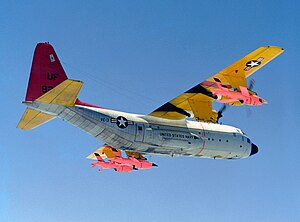
The Lockheed AC-130 gunship is a heavily armed, long-endurance, ground-attack variant of the C-130 Hercules transport, fixed-wing aircraft. It carries a wide array of ground-attack weapons that are integrated with sophisticated sensors, navigation, and fire-control systems. Unlike other modern military fixed-wing aircraft, the AC-130 relies on visual targeting. Since its large profile and low operating altitudes around 7,000 feet make it an easy target, its close air support missions are usually flown at night.
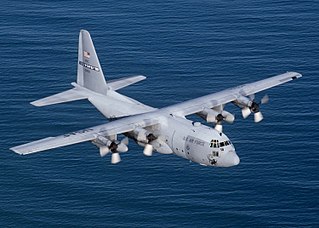
The Lockheed C-130 Hercules is an American four-engine turboprop military transport aircraft designed and built by Lockheed. Capable of using unprepared runways for takeoffs and landings, the C-130 was originally designed as a troop, medevac, and cargo transport aircraft. The versatile airframe has found uses in other roles, including as a gunship (AC-130), for airborne assault, search and rescue, scientific research support, weather reconnaissance, aerial refueling, maritime patrol, and aerial firefighting. It is now the main tactical airlifter for many military forces worldwide. More than 40 variants of the Hercules, including civilian versions marketed as the Lockheed L-100, operate in more than 60 nations.

The Lockheed Martin EC-130 series comprises several slightly different versions of the Lockheed C-130 Hercules that have been and continue to be operated by the U.S. Air Force and, until the 1990s, the U.S. Navy.

The Lockheed WC-130 is a high-wing, medium-range aircraft used for weather reconnaissance missions by the United States Air Force. The aircraft is a modified version of the C-130 Hercules transport configured with specialized weather instrumentation including a dropsonde deployment/receiver system and crewed by a meteorologist for penetration of tropical cyclones and winter storms to obtain data on movement, size and intensity.

The Lockheed HC-130 is an extended-range, search and rescue (SAR)/combat search and rescue (CSAR) version of the C-130 Hercules military transport aircraft, with two different versions operated by two separate services in the U.S. armed forces.

The Lockheed D-21 is an American supersonic reconnaissance drone. The D-21 was initially designed to be launched from the back of an M-21 carrier aircraft, a variant of the Lockheed A-12 aircraft. The drone had maximum speed in excess of Mach 3.3 at an operational altitude of 90,000 feet. Development began in October 1962. Originally known by the Lockheed designation Q-12, the drone was intended for reconnaissance deep into enemy airspace.

The Lockheed X-7 was an American unmanned test bed of the 1950s for ramjet engines and missile guidance technology. It was the basis for the later Lockheed AQM-60 Kingfisher, a system used to test American air defenses against nuclear missile attack.
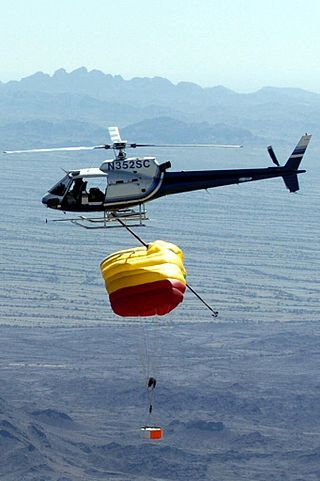
Mid-air retrieval is a technique used in atmospheric reentry when the reentering vehicle is incapable of a satisfactory unassisted landing. The vehicle is slowed by means of parachutes, and then a specially-equipped aircraft matches the vehicle's trajectory and catches it in mid-air.

The AQM-35 was a supersonic target drone produced by the Northrop Corporation.

The 100th Air Refueling Wing, nicknamed the Bloody Hundredth, is a United States Air Force unit assigned to the Third Air Force, United States Air Forces in Europe – Air Forces Africa. It is stationed at RAF Mildenhall, Suffolk, United Kingdom. It is also the host wing at RAF Mildenhall.

UAVs include both autonomous drones and remotely piloted vehicles (RPVs). A UAV is capable of controlled, sustained level flight and is powered by a jet, reciprocating, or electric engine. In the twenty first century technology reached a point of sophistication that the UAV is now being given a greatly expanded role in many areas of aviation.

The Ryan Model 147 Lightning Bug is a jet-powered drone, or unmanned aerial vehicle, produced and developed by Ryan Aeronautical from the earlier Ryan Firebee target drone series.
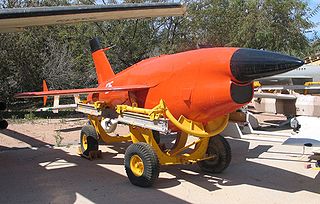
The Ryan Firebee is a series of target drones developed by the Ryan Aeronautical Company beginning in 1951. It was one of the first jet-propelled drones, and remains one of the most widely used target drones ever built.

The Ryan AQM-91 Firefly was a developmental drone developed during the Vietnam War to perform long-range reconnaissance, especially into China.

The 11th Attack Squadron is a United States Air Force unit assigned to the 432d Wing Air Combat Command at Creech Air Force Base near Indian Springs, Nevada. It flies General Atomics MQ-9 Reaper Unmanned aerial vehicles. In 1995 the 11th became the first Remotely Piloted Aircraft (RPA) squadron in the Air Force.
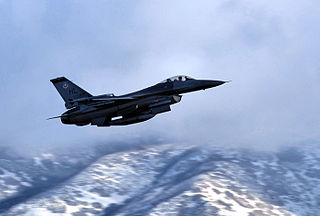
The 514th Flight Test Squadron is a squadron of the United States Air Force, which has been stationed at Hill Air Force Base, Utah since 1973, performing functional flight checks on aircraft undergoing major maintenance.

The 556th Test and Evaluation Squadron is a United States Air Force unit. It is assigned to the 53d Test and Evaluation Group at Creech Air Force Base, Nevada, and conducts unmanned aircraft testing.

The 4080th Strategic Reconnaissance Wing is a discontinued United States Air Force (USAF) wing last assigned to the 12th Strategic Aerospace Division of Strategic Air Command (SAC) at Davis–Monthan AFB, Arizona. It was SAC's high altitude reconnaissance wing for its existence and was the first USAF wing to operate the Lockheed U-2. It was discontinued as part of a program to replace operational units controlled by major commands with those controlled by USAF whose lineages could be continued.
The 4028th Strategic Reconnaissance Squadron was a component of the 4080th Strategic Reconnaissance Wing, Strategic Air Command, that operated Lockheed U-2 spy planes out of Laughlin AFB, Texas, and Davis–Monthan AFB, Arizona, in the late 1950s and early 1960s. The unit is also sometimes referred to as the 4028th Strategic Reconnaissance Weather Squadron. It was from this unit that the pilots involved in overflights of Cuba during the Cuban Missile Crisis were drawn. Detachments of the 4028th were deployed to Japan and South Vietnam.

On May 2, 2018, a Lockheed WC-130H transport aircraft of the Puerto Rico Air National Guard crashed in the US state of Georgia, shortly after departing from Savannah Air National Guard Base. The aircraft crashed on Georgia State Route 21 at 11:26 local time. All nine airmen were killed in the accident. All nine were members of the Puerto Rico Air National Guard.
